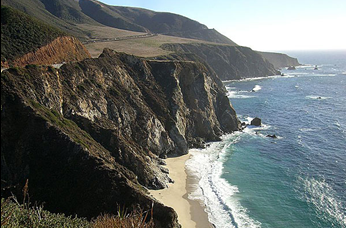Product Description
Peter Canty, “Pacific Cove”, Oil on canvas 2001


PETER CANTY (b. 1938) USA
Pacific Cove 2001
Oil on canvas
Signed: P. Canty 2001, Santa Cruz, CA 5 (in a circle on back)
Canvas size: H: 30” x L: 40”
Framed size: H: 38” x L: 48”
Peter Canty received his BA in art from the Chouniard Art Institute, Los Angeles (now California Institute of the Arts) and an MA from the University of California, Santa Cruz in 1969. Heavily influenced by the Post-Impressionist masters Van Gogh, Gauguin and Cezanne, in his own he words he describes his interest in landscapes, believing they are, “the best vehicle for motion, force, and color dynamics.” Although his work reference realistic subjects, Canty’s imagery is drawn strictly from his own imagination.
Peter Canty, “Pacific Cove”, Oil on canvas 2001
GEORGE WASHINGTON MAHER (1864-1926) USA
Rockledge “Man’s chest of drawers” for E.L. King (unique) 1911-12
Original vintage cream/white painted surface (some losses to the top surface) on hardwood structure with original bronze drawer pulls (natural patina)
Provenance: Ernest & Grace King, henceforth descended through the King family; Private Collection, Wisconsin from Hollander Auction Gallery, Milwaukee WI (1982); Private Collection, New York
Illustrated: The Western Architect, “Geo. W. Maher, a democrat in Architecture” (March 1914, n. p. – for a period photograph showing this model in situ in the master bedroom), Prairie School Architecture: Studies from “The Western Architect” H. Allen Brooks (Toronto, 1975, p. 179).
H: 71” x W: 44 ¾” x D: 26 ¼”
(Gift to The Wolfsonian-FIU, Miami Beach, FL)
Information and other examples from the Maher / Rockledge commission can be found in the following books and publications: The Art that is Life: The Arts and Crafts Movement in America, 1875-1920, ed. Wendy Kaplan, (Boston: Museum of Fine Arts, Boston, Little, Brown and Company, 1987), pp. 396-400,The Ideal Home: The History of Twentieth Century American Craft, 1900-1920, Janet Kardon (New York: Abrams, 1993) cover illus. and p. 205; Geo. W. Maher Quarterly, Oct.-Dec., 1992, pp. 1, 16, 17; Arts, December, 1995, The Minneapolis Institute of Arts, Minneapolis, Minn. cover and back cover.
Examples of artworks from Rockledge are in the permanent collections of The Metropolitan Museum of Art, Cooper-Hewitt National Design Museum, NY, The Brooklyn Museum of Art, The Newark Museum, The Baltimore Museum of Art, The Minneapolis Institute of Arts, The Milwaukee Art Museum, The Wolfsonian, Miami Beach, FL, The Boston Museum of Fine Arts, the Houston Museum of Fine Arts, the Dallas Museum of Art and the St. Louis Art Museum.
In 1912 George Washington Maher designed Rockledge, a summer residence near Homer, Minnesota, for E.L. King. Sited just beneath a cliff along the Mississippi River, Rockledge is considered the finest residence of Maher’s career and a perfect example of his motif-rhythm theory of architectural design.
***Please note that the chest in the period illustration (as the pairing on view) is the woman’s version chest of drawers, which is slightly smaller and has the open segmental arched top. This chest can now be found in the collection of the Milwaukee Art Museum. On the other hand the man’s chest of drawers is a larger piece of furniture and has the segmental arch contained within the overall rectangular form of the back support. As a further note, the rocker is now in the permanent collection of the Detroit Institute of Art, courtesy of Historical Design Inc.
